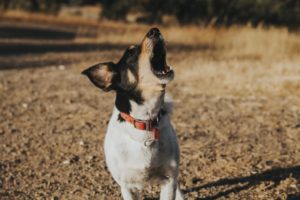No matter how close you are to your dogs, sometimes the unexpected can happen and your dog bites you. So now what? The first step, of course, is to stay calm. This isn’t the end of your relationship and doesn’t mean that your dog has turned into an aggressive killer. There are lots of reasons a dog might bite. To find the solution, you first have to figure out your cause.
If your dog is a puppy and suddenly clamps down on your thumb, don’t worry. All puppies go through this phase, and it’s your perfect opportunity to correct the behavior so it diminishes in the future, as we explain here.
But what if your dog isn’t a puppy? Here are the reasons that a dog may bite:
Maternal instincts
The first two are easy to deal with. Is your dog a mother with puppies? Then respect their space and let the mother dog deal with her litter until she’s ready to let them be around other people.
Pain
Is your dog in pain? If you’re bitten unexpectedly and none of the other three reasons apply, it’s time to take a trip to the vet. Dogs are very good at hiding pain, but if you touch a sore spot that they’ve been keeping secret, they can react instinctively with a warning nip. Your vet can determine whether your dog is feeling pain, or if they have some other neurological condition that caused the unexpected behavior.
This leaves possessiveness, fear, and the prey drive, of which the first is the most serious and takes longer to deal with. Let’s look at the other two first.
Fear
If your dog bites you because you scared him, then you need to build trust in the relationship. It may just be a one-time thing — you moved toward the dog too quickly, or sat too close to him while he was sleeping, for example. But if you don’t build trust after an incident like this, it can happen more often whenever your dog is feeling insecure, and anyone can be the target.
Build trust
Your best trust-building exercise is walking together, provided that you are acting as a calm, assertive Pack Leader. This helps your dog get used to the idea that nothing bad is going to happen to her while you’re around and reinforces her trust in you. Once you’re both comfortable on the walk, work together to expose her to new situations, people, and dogs. Increasing novelty for your dog will help reduce her fear.
Work on discipline
Second, work on discipline by teaching him simple tricks, particularly sit and stay, using positive reinforcement. At first, this may be a treat, but if you gradually switch over the reward to praise and affection, then you become the treat. Your dog will associate you with pleasant things, and so become far less likely to react with fearful aggression.
Prey drive
When a dog bites because of their prey drive, it’s frequently accidental — the dog was aiming for the rope toy and missed, hitting your hand, for example. After this has happened once, it’s time to adjust the game. Instead of playing tug-of-war, refocus your dog by playing fetch. This will satisfy her prey drive while keeping accidental human targets out of range. Also combine discipline with the game — you don’t throw the ball until she sits and waits calmly for you to do it.
If your dog is high energy and can get aggressively distracted by his prey drive, then consider professional training in things like agility or treibball, particularly if your dog is a herding breed, although agility will work with any breed of dog that’s healthy enough to do it.
Possessiveness
This leaves us with possessiveness — the kind of bite that happens when you try to take something away from your dog, like a toy or food. This one isn’t an accidental or spontaneous reaction. It’s your dog responding to you with dominance and defensiveness and is the one kind of biting behavior that, if not corrected, can turn into aggression.
Rules, boundaries, and limitations
To deal with a possessive biter, you must establish rules, boundaries, and limitations, and enforce them. This is to establish for your dog that you, the Pack Leader, are the source of everything she is allowed to have or do, whether it is food, water, treats, toys, or attention. In order to get what she wants, she is going to have to go into a calm, submissive state first.
Obedience training
This is also a good time to teach him the “leave it” command, which means that the dog has to put down and move away from anything in his mouth. You can start this with a favorite toy. While your dog is holding it, present a treat while telling him, “Leave it.” He gets the treat when he puts down the toy and is no longer paying attention to it.
Gradually extend this so that you pick up the toy when she puts it down and then you give her the treat. Eventually, you should be able to get your dog to drop whatever is in her mouth on command, and even be able to take something out of her mouth.
Preventing food aggression
The idea is similar with the food bowl. Once you’ve established the rules around feeding and the leave it command, begin to approach the bowl while he’s eating, and toss a couple of high-value treats in. Repeat this from time to time while he’s eating. The idea is that your dog will begin to associate humans approaching his bowl with good things, because he gets special treats.
If your dog is specifically showing signs of food aggression, here are more tips on dealing with it.
Stay calm
Humans manipulate the world mostly with their hands, while dogs manipulate it mostly with their mouths. Needless to say, a dog’s teeth are a lot sharper than human fingers, so unintentional or accidental bites can happen. Just remember when they do it that it isn’t the end of the world. Stay calm, figure out what caused it, and then take the right steps to prevent it from happening again.
Were you ever bitten by your own dog? How did you handle it?











